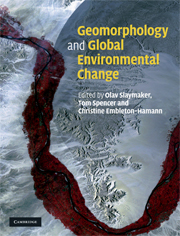Book contents
- Frontmatter
- Contents
- List of contributors
- Preface
- Acknowledgements
- List of acronyms and abbreviations
- 1 Landscape and landscape-scale processes as the unfilled niche in the global environmental change debate: an introduction
- 2 Mountains
- 3 Lakes and lake catchments
- 4 Rivers
- 5 Estuaries, coastal marshes, tidal flats and coastal dunes
- 6 Beaches, cliffs and deltas
- 7 Coral reefs
- 8 Tropical rainforests
- 9 Tropical savannas
- 10 Deserts
- 11 Mediterranean landscapes
- 12 Temperate forests and rangelands
- 13 Tundra and permafrost-dominated taiga
- 14 Ice sheets and ice caps
- 15 Landscape, landscape-scale processes and global environmental change: synthesis and new agendas for the twenty-first century
- Index
7 - Coral reefs
Published online by Cambridge University Press: 05 July 2015
- Frontmatter
- Contents
- List of contributors
- Preface
- Acknowledgements
- List of acronyms and abbreviations
- 1 Landscape and landscape-scale processes as the unfilled niche in the global environmental change debate: an introduction
- 2 Mountains
- 3 Lakes and lake catchments
- 4 Rivers
- 5 Estuaries, coastal marshes, tidal flats and coastal dunes
- 6 Beaches, cliffs and deltas
- 7 Coral reefs
- 8 Tropical rainforests
- 9 Tropical savannas
- 10 Deserts
- 11 Mediterranean landscapes
- 12 Temperate forests and rangelands
- 13 Tundra and permafrost-dominated taiga
- 14 Ice sheets and ice caps
- 15 Landscape, landscape-scale processes and global environmental change: synthesis and new agendas for the twenty-first century
- Index
Summary
Introduction
This chapter examines the implications of global environmental change for the geomorphology of coral reefs and reef-associated sedimentary landforms such as beaches and reef islands. These tropical ecosystems cover an estimated 284 to 300 km2 of the Earth' s surface (Spalding et al., 2001) and are considered among the most valuable on Earth, providing economic goods and services worth in excess of US$375 billion a–1 to millions of people (Best and Bornbusch, 2005). They are zones of high biological diversity, habitat for about a quarter of all known marine species, important components of the global carbon cycle, and provide the physical foundation for a number of mid-ocean nation states. Indeed, reefs possess benefits under four categories of ecosystem services (Millennium Ecosystem Assessment, 2005). Such benefits include: regulation of incident oceanographic swell conditions to control reef and lagoon circulation, reduce shoreline erosion, protect beaches and coastlines from storm surges, and control beach and island formation; provision of food resources (fisheries) and aggregates for building (coral and sand), as well as the provision of land surface area and associated subsurface water resources, especially through reef island construction; supporting nutrient cycling and active carbonate production to build reef and reef island structures; and cultural benefits that include spiritual identity for indigenous communities and potential for tourism and recreation-based income.
Coral reefs worldwide are considered to be in serious ecological decline as a consequence of anthropogenic impacts, natural stresses and climate change (e.g. Hughes et al., 2003; Buddemeier et al., 2004). Broad-scale assessments (e.g. Wilkinson, 2004) have argued that 20% of the world' s coral reefs have been destroyed and that 25% of reefs are under imminent or long-term risk of collapse. In the Indo-Pacific region, it has been calculated that coral cover loss rates were 2% per year (losses of 3168 km2 a–1) between 1997 and 2003 (Bruno and Selig, 2007).
- Type
- Chapter
- Information
- Geomorphology and Global Environmental Change , pp. 180 - 213Publisher: Cambridge University PressPrint publication year: 2009
- 20
- Cited by



